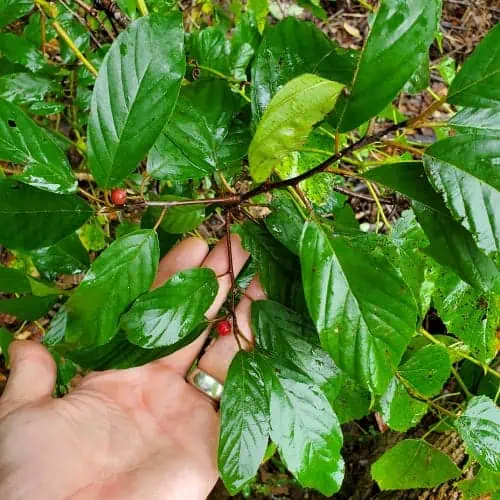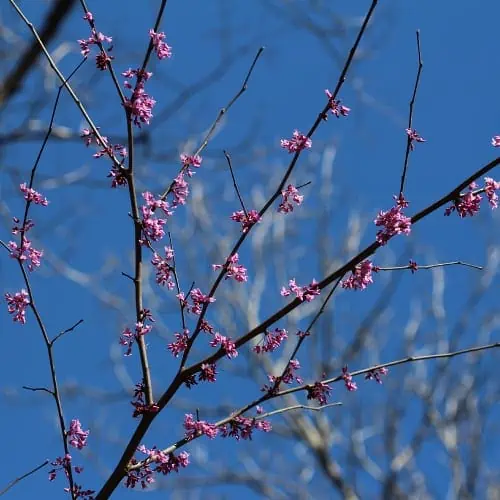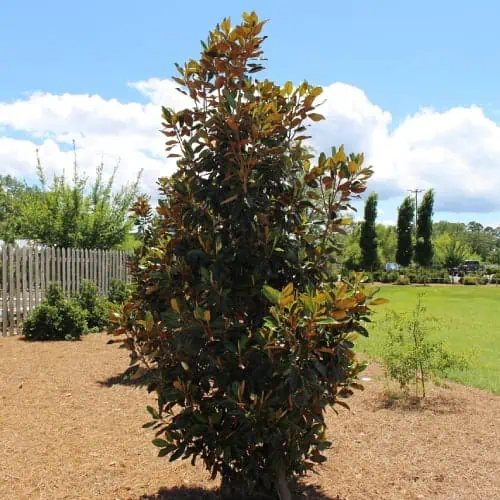
A state known for its challenging conditions, Texas may initially appear to be inhospitable to many types of plants. Though it does have some of the warmest summer temperatures, with large regions experiencing prolonged droughts each year, it can prove to be a wonderful setting for some of the hardiest plants around. The diverse gulf coast, inner plains, and panhandle canyons offer contrasting climates for the cultivation of low-maintenance ornamentals.
Trees are some of the best additions to Texan gardens, even small ones. Once they are well-established, some species can persist through parched summers, making up for halted growth in rainy seasons. Apart from adding diversity and texture to small spaces, they can also provide shade for tender herbs requiring dappled or partial sun exposure. A nuanced selection of native trees should improve the stability of poor soils, enhancing their properties for companion plants.
When grown in the right locations, small trees can have an enormous impact on the garden. Their manageable mature height, coupled with the limited spread of their roots and their canopy, should add complexity to your space without casting it in full shade or dropping an excessive amount of leaves. The species below are some of the most beautiful native and non-native (yet non-invasive) trees with a knack for growing small.
- Stylish Concrete Planter - Unveil a modern design boasting graceful curves and an authentic surface finish! Enhance your space's allure with...
- Handmade Plant Pot - Crafted from an exclusive blend of concrete and fiberglass formula, harnessing the full spectrum of their benefits:...
- Large & Versatile - Whether showcasing a plant indoors or placed on the front steps, porch, or patio, this spacious planter seamlessly...
1) Yaupon holly (Ilex vomitoria)

Widely used as an ornamental plant for landscaping projects, the yaupon holly is a small, evergreen tree. It grows to a maximum height of just 9 meters (30 feet), with many specimens measuring about 5 – 6 meters (16 – 20 feet) on average. It is set apart by its slender, woody features, which have a distinctly smooth and light grey appearance. Borne on its hairy shoots are alternately arranged leaves with coarsely serrated margins.
The shiny, red fruits of the yaupon holly are perhaps its most charming and ecologically important feature. Note, however, that they only appear on female specimens of this dioecious plant. If they’re able to last into winter, the berries are a valuable food source for birds, armadillos, black bears, foxes, raccoons, and skunks. Native deer may occasionally browse on the foliage and outermost branches.
Horticulturists favor this species for manicured gardens as the branches are highly adaptable to being pruned back and shaped into hedges. Some well-loved cultivars, which tend to be grown because of their dwarf sizes or the weeping orientation of their branches, include ‘Grey’s Weeping’, ‘Pride of Houston’, and ‘Will Fleming’.
2) Desert willow (Chilopsis linearis)

In the wild, the desert willow thrives as a deep-rooted plant along the edges of sandy streams and in areas receiving seasonal washes of surface waters. As its mature plants can be manipulated to grow to a wide range of maximum heights, 1.5 – 8 meters (5 – 26 feet), it can be treated as a large shrub or a small tree. Naturally, the branches arise to create an irregularly-shaped canopy. They can, however, be pruned back to follow the shape of a conventional tree.
Despite its common name, this deciduous species is not actually a willow. In fact, it is a type of catalpa under the Bignoniaceae family. In its native range, it is present as two subtly different subspecies; C. linearis linearis is the specific taxon found in West Texas. This subspecies is frequently cultivated as a small, ornamental tree because of its tolerance for hot conditions and dry substrates.
If you’d like to attract large bumblebees and carpenter bees to your Texan garden, the desert willow is highly recommended. Its lovely inflorescences, which consist of lavender to light pink blooms, appear from May to September. One of the more popular cultivars, ‘Rio Salado’, is prized for its deep, magenta-toned blooms.
3) Carolina buckthorn (Frangula caroliniana)

Usually cultivated as a deciduous shrub or small tree, the Carolina buckthorn thrives in a wide range of natural habitats. In the Edwards Plateau, for example, it is naturally present in stream banks, ravines, and woody bottomlands. It favors partially shaded conditions and regularly moistened, rocky substrates. It can thus be grown as a specimen tree in parts of the garden that are frequently cast in shade.
Though this species is commonly referred to as a “buckthorn”, it doesn’t actually have any thorns. Its branches, which bear strikingly shiny and deep green leaves, reach heights of 3.6 – 4.5 meters (12 – 15 feet) on average. In truly optimal conditions, however, a well-cared-for specimen can grow as tall as 12 meters (39 feet)! Nonetheless, its branches can be regularly pruned back to maintain a desirable height and shape.
In late spring, mature F. caroliniana trees produce small, relatively inconspicuous blooms along their leaf axils. Once these are pollinated, they develop into tough, red fruits. As the fruits ripen, they become increasingly black and juicy. Many songbirds may consume the fruits. At this stage, you may also opt to collect the fruits and directly sow them into fertile soil.
4) Crabapple trees (Malus spp.)

Crabapple trees are quite popular in Texas for several reasons; they naturally occur in some parts of the state, are remarkably attractive once they come into bloom, and have moderate water needs throughout the year. These small trees are best known, of course, for producing juicy apples. Their most popular cultivars are the very sources of store-bought orchard apples, such as ‘Golden Delicious’ and the ‘Granny Smith’ apple.
With 30+ species and dozens of attractive cultivars, there’s a crabapple tree for just about any type of small garden. On average, these ornamental trees grow to a maximum height of just 4 – 12 meters (13 – 39 feet). The award-winning cultivars are prized for their compact appearance, their eye-catching spring blossoms, their striking fall colors, and their long-lasting fruits.
The Texas crabapple (Malus ioensis var. texana), which is naturally found only in the Edwards Plateau, is fantastic as an accent tree. Its wild stands are unfortunately threatened due to the rapid browsing habits of native deer. If you’d like to cultivate some in your small garden, make sure to protect their seedlings until they have become well-established.
5) Texas persimmon (Diospyros texana)

A member of the Ebenaceae family of ebony and persimmon trees, D. texana is a semi-evergreen species. A single specimen, once mature, tends to consist of multiple trunks that measure up to 3 – 12 meters (9.8 – 39.4 feet) tall. The trunks are distinguished by their smooth and reddish bark, which gradually peels away to reveal lighter-colored layers.
In the wild, Texas persimmon is present in a wide range of environments. Its stands have been sighted in the Edwards Plateau, Chihuahuan Desert, and many other types of xeric and grassy biomes. However, its densest stands tend to favor conditions in transitional landscapes, such as along the edges of prairies and through the well-drained sections of riparian zones.
Tolerant of both full sun and partial shade conditions, the Texas persimmon is versatile enough to be grown as an ornamental in small gardens. Ensuring that it receives its basic needs reaps both aesthetic rewards and biological services. Pollinators and grazers seek its branches for both food and shelter. Revered as the “giving tree” by Native Americans, it is also known for the high quality of its heartwood and for the nutritional properties of its fruits and sap.
6) Eastern redbud (Cercis canadensis)

The eastern redbud is often cultivated as a small, ornamental tree in gardens, parks, and public spaces. Oklahoma’s state tree, it is known for the twisted appearance of its short trunk and the graceful spread of its branching canopy. Its outermost twigs, which are covered in lighter-colored lenticels, tend to have a zigzag orientation. These bear 3- to 4-inch (7.6 – 10.2 cm) long, thin, heart-shaped leaves with smooth margins.
The appearance of this small tree drastically changes throughout the seasons. In winter, its bare branches begin to produce tiny, deep-colored buds along their tips. In spring, the buds bloom into showy, light-to-dark pink blooms. The resulting appearance is a splendidly vivid canopy that, without fail, should bring many types of bees to the garden. The clusters of flowers, which bloom before new leaves begin to appear, may even be situated on the trunk itself.
The showy appearance of this landscape tree does not stop there! In fall, its leaves turn into brilliant orange to red hues, creating a fiery canopy to mark the cooling temperatures. If your Texan garden needs a focal piece, this is definitely one plant that could rise up to the task. Do note, however, that its roots will require supplementary moisture in arid locations.
7) Dwarf southern magnolia (Magnolia grandiflora ‘Little Gem’)

Hardy to USDA zones 7 – 9, the dwarf southern magnolia is a charming and low-maintenance cultivar of M. grandiflora. It is often grown as a specimen plant in small to medium-sized gardens because it seldom grows to more than 6 meters (20 feet) tall. Tolerant of full sun to partial shade, it can easily be cultivated in areas with rich, well-draining substrates.
Well-established specimens of dwarf southern magnolia can fare well in sandy or clay-based substrates. Their roots can tolerate brief periods of dryness, but keep in mind that prolonged droughts can cause the tree to suffer and ultimately die back. If your garden is situated in an area that is moisture-deprived all throughout summer, make sure you provide this tree with supplementary sources of water.
Given its basic preferences, a mature dwarf southern magnolia should thrive as an evergreen tree. Its leathery, dark green foliage arises on compactly arranged branches. This gives the tree a dense and shrub-like appearance, especially as the stems may arise from the lower parts of the trunk. In late spring to midsummer, the dwarf southern magnolia’s fragrant, white blooms may appear at the tips of bushy stems.
8) Mexican buckeye (Ungnadia speciosa)

The Mexican buckeye naturally occurs in the dry, rocky, and sandy canyons of the warmer parts of Texas. This hardy tree is able to persist when provided with minimal moisture. Its tolerance for dry conditions makes it a great choice as a specimen or hedge tree in xeric gardens. Its opulent appearance during its bloom period, which lasts from late winter to early spring, is a testament to how productive trees can be when faced with challenging conditions.
Like the eastern redbud, the Mexican buckeye is known for how pink and vivid its canopy becomes during its bloom period. Its new leaves also shortly arise after the buds come into full bloom, but they initially appear as light bronze in color. From a distance, this species can be misidentified as a redbud, especially as their bloom periods may coincide.
If you’re choosing between cultivating the Mexican buckeye or the eastern redbud as the sole specimen tree of a small garden, look into the differences in their basic requirements. If your garden is prone to experiencing notably hot summers, you might want to opt for the drought-tolerant buckeye. Conversely, if it is partly cast in shade and experiences prolonged periods of rainfall, it would be wise to go for the redbud instead.
9) Crepe myrtle (Lagerstroemia indica)

Although the crepe myrtle is not native to Texas, it is frequently cultivated as a landscape tree in the southern US. Its tolerance for summer heat makes it a great choice for small gardens with full sun exposure. This low-maintenance, no-fuss tree is also seldom associated with invasive growth. Though its fibrous roots can cover a considerable surface area of soil, they do not grow aggressively or produce suckering organs.
If you’re concerned about crepe myrtle overgrowing your small yard or unfavorably altering your native ecosystem, you can opt for its infertile hybrids or cultivars. This way, you can truly enjoy the tree’s bloom period without worrying about the consequences of self-propagation. Local horticulturists recommend these 10- to 20-foot cultivars: ‘Appalachee’, ‘Osage’, ‘Centennial Spirit’, and more.
Generally, crepe myrtle trees have warm-toned trunks and branches that produce dependably dense and radiant foliage. Their lush canopies are particularly phenomenal in midsummer to early fall, during which their tufts of colorful inflorescences appear. Over a backdrop of textural leaves, the delicate, light to deep pink blooms may seem to glow.
10) Dogwood trees (Cornus spp.)

For year-round interest, Cornus species tend to be some of the best specimen trees for small gardens. Commonly known as dogwoods, these plants are largely distinguished by their propensity to bloom heavily and by their distinct bark. Cornus florida, which favors slightly acidic and loamy soil, is particularly well-adjusted to the climate of East Texas.
As dogwood trees tend to have shallow roots, they aren’t as resistant to prolonged droughts as the trees of semi-arid to arid regions. However, if they are consistently provided with moisture, they can continue to flourish in sun-exposed and well-draining gardens. Keeping established specimens well-mulched should do the trick!
In spring, ornamental dogwoods begin to bloom. The flowers of well-established trees may linger for several weeks, attracting pollinators like silk moths, bees, and butterflies. The fertilized flowers develop into colorful, edible drupes. The fruits that persist into winter become an important food source for many birds and mammals.


